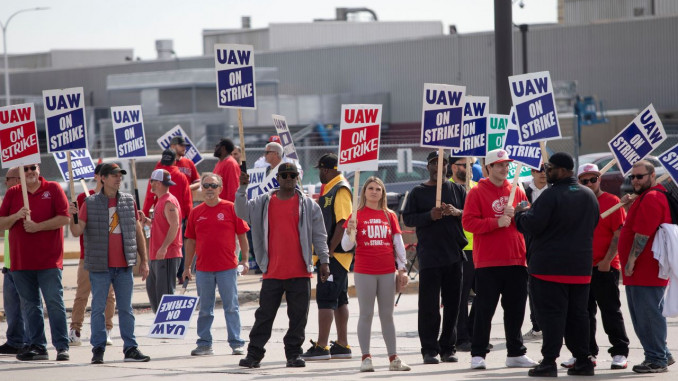
In the early hours of Friday, September 15th, union officials of the United Auto Workers (UAW) called on 12,700 workers at three assembly plants to shut them down. This was part of the strategy of the UAW in dealing with the contract expiration of the “Big Three” auto companies – Ford, General Motors (GM), and Stellantis, which Chrysler has merged with. Instead of targeting one of the Big Three, the newly elected union officials have decided to take on all three.
In the days leading up to the expiration of the UAW auto contract, the newly elected president of the UAW, Shawn Fain, used language few union officials have used in the past decades: “Some in the media claim that our union is engaged in class warfare… the truth is the working class in this country has been under attack in a one sided class war for decades.” Now, it will not just be the rich engaged in the fight. It will be two-sided, with the possibility of 150,000 auto workers at around 70 plants mobilizing their forces.
Among the demands of the strike is to eliminate the pay and benefit structures of the tier system, which varies company to company. New hires and temps start at less than $17 an hour and top out after four years at under $20 an hour. Full-time workers, often doing the same work, are paid around $32 an hour. Temps are not guaranteed a full work week and can also be forced into long hours of overtime along with other workers. With inflation of 20% over the life of their contract, many auto workers are living on the edge.
Other demands include wage increases for everyone and Cost Of Living Adjustment (COLA) and job security with the shift to producing electric vehicles (EVs) which require fewer assembly workers.
This hard work brought the Big Three around $250 billion in profits in North America in the last decade, and $21 billion in the first six months of this year. Their CEOs had their salaries increased 40% to an average of $25 million per year, over the last four years. Meanwhile worker pay only went up 6%.
The auto companies are using the transition to EVs as a threat to hang over workers’ heads. We saw this in the mid 1970s and ’80s when the former union officials pushed wage and benefit concessions using the idea of a “partnership” between the workers and the corporations, supposedly to save the companies faced with competition from Japanese auto companies. During the economic crisis of 2008 and later, the Bush and Obama administrations gave the auto companies nearly $90 billion of our tax dollars and demanded even more concessions.
The current union officials and certainly the workers have said it is time to draw the line. Similar to UPS, the union officials have organized “practice pickets” at factories to activate workers and spread information about the negotiations. Many workers are ready and eager to show their willingness to strike. And some workers have questioned why wage a limited strike at three plants, when they could have shut the entire industry down. The union officials say their strategy is to call more workers out in surprise strikes, if necessary. We shall see.
Fain is right, this is class war and we have been losing. But we have the forces to win. Today it is 150,000 auto workers. Last month It was 340,000 UPS workers and last fall, 125,000 rail workers who threatened to strike. In recent years, health care workers, teachers and others in many other parts of the economy have also mobilized their forces against similar attacks.
More workers are seeing that we face a common enemy that will use everything it can to keep the profits rolling in. We confront this every day at work. We can organize now to begin to deal with the daily problems and prepare for the larger fights.
We can’t predict the outcome of the auto strike. Regardless of how far it goes and what their gains are, they will have more than if they didn’t fight. Their fight is our fight!

